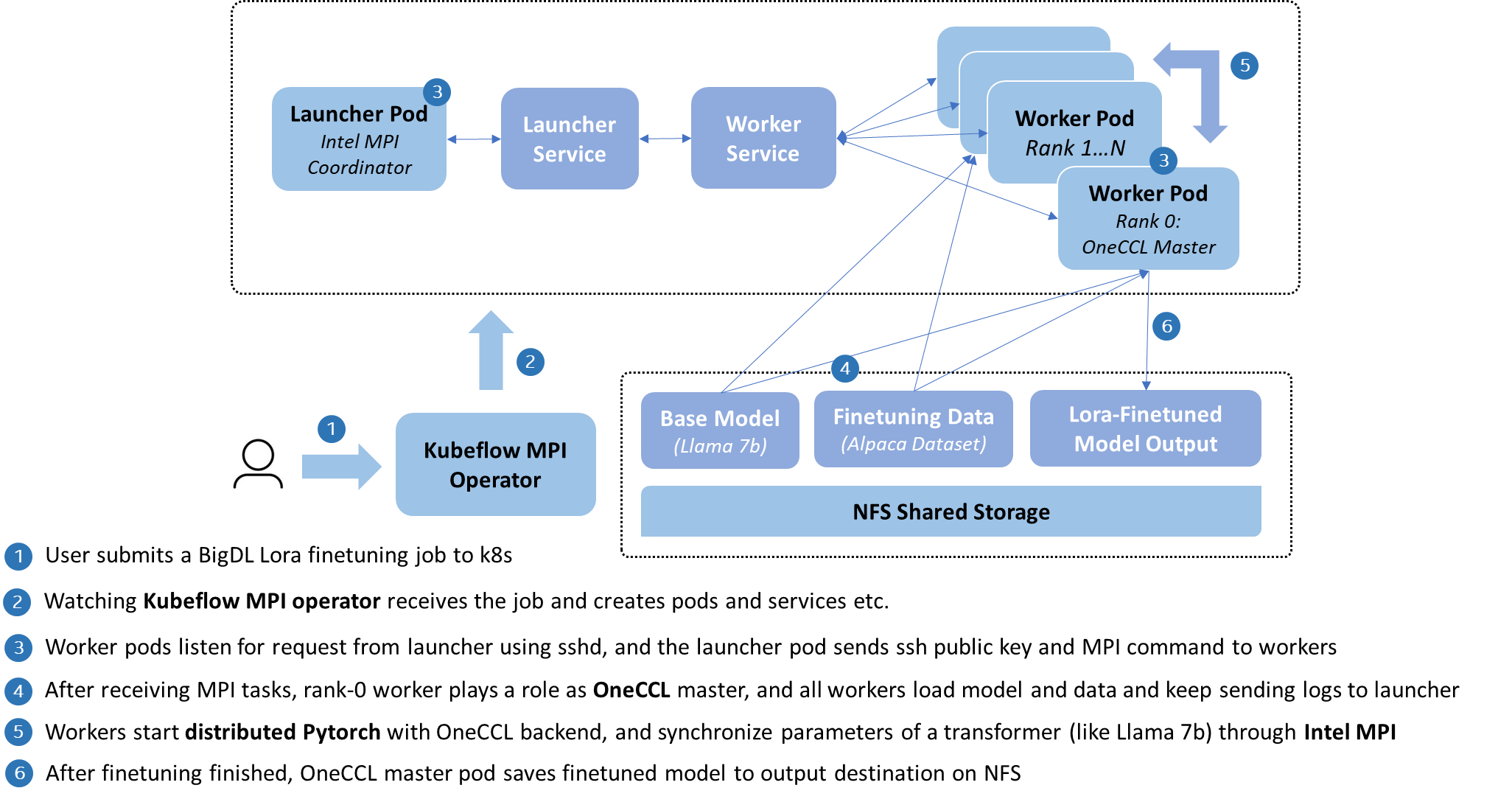* Fix docker images * add-apt-repository requires gnupg, gpg-agent, software-properties-common * update * avoid importing ipex again |
||
|---|---|---|
| .. | ||
| docker | ||
| kubernetes | ||
| README.md | ||
Run BF16-Optimized Lora Finetuning on Kubernetes with OneCCL
Alpaca Lora uses low-rank adaption to speed up the finetuning process of base model Llama2-7b, and tries to reproduce the standard Alpaca, a general finetuned LLM. This is on top of Hugging Face transformers with Pytorch backend, which natively requires a number of expensive GPU resources and takes significant time.
By constract, IPEX-LLM here provides a CPU optimization to accelerate the lora finetuning of Llama2-7b, in the power of mixed-precision and distributed training. Detailedly, Intel OneCCL, an available Hugging Face backend, is able to speed up the Pytorch computation with BF16 datatype on CPUs, as well as parallel processing on Kubernetes enabled by Intel MPI.
The architecture is illustrated in the following:
As above, IPEX-LLM implements its MPI training with Kubeflow MPI operator, which encapsulates the deployment as MPIJob CRD, and assists users to handle the construction of a MPI worker cluster on Kubernetes, such as public key distribution, SSH connection, and log collection.
Now, let's go to deploy a Lora finetuning to create a LLM from Llama2-7b.
Note: Please make sure you have already have an available Kubernetes infrastructure and NFS shared storage, and install Helm CLI for Kubernetes job submission.
1. Install Kubeflow MPI Operator
Follow here to install a Kubeflow MPI operator in your Kubernetes, which will listen and receive the following MPIJob request at backend.
2. Download Image, Base Model and Finetuning Data
Follow here to prepare IPEX-LLM Lora Finetuning image in your cluster.
As finetuning is from a base model, first download Llama2-7b model from the public download site of Hugging Face. Then, download cleaned alpaca data, which contains all kinds of general knowledge and has already been cleaned. Next, move the downloaded files to a shared directory on your NFS server.
3. Deploy through Helm Chart
You are allowed to edit and experiment with different parameters in ./kubernetes/values.yaml to improve finetuning performance and accuracy. For example, you can adjust trainerNum and cpuPerPod according to node and CPU core numbers in your cluster to make full use of these resources, and different microBatchSize result in different training speed and loss (here note that microBatchSize×trainerNum should not more than 128, as it is the batch size).
Note: dataSubPath and modelSubPath need to have the same names as files under the NFS directory in step 2.
After preparing parameters in ./kubernetes/values.yaml, submit the job as beflow:
cd ./kubernetes
helm install ipex-llm-lora-finetuning .
4. Check Deployment
kubectl get all -n ipex-llm-lora-finetuning # you will see launcher and worker pods running
5. Check Finetuning Process
After deploying successfully, you can find a launcher pod, and then go inside this pod and check the logs collected from all workers.
kubectl get all -n ipex-llm-lora-finetuning # you will see a launcher pod
kubectl exec -it <launcher_pod_name> bash -n ipex-llm-lora-finetuning # enter launcher pod
cat launcher.log # display logs collected from other workers
From the log, you can see whether finetuning process has been invoked successfully in all MPI worker pods, and a progress bar with finetuning speed and estimated time will be showed after some data preprocessing steps (this may take quiet a while).
For the fine-tuned model, it is written by the worker 0 (who holds rank 0), so you can find the model output inside the pod, which can be saved to host by command tools like kubectl cp or scp.
